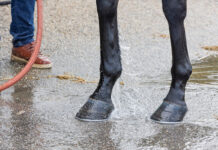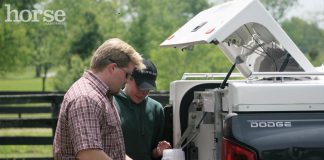The challenges of training a young horse are almost as plentiful as the joys; the rewards of accomplishment can feel like a roller coaster when mixed with the anxieties of working with an impressionable animal. Add to this list the health issues a young animal’s developing skeleton presents and you may really feel the pressure, especially if you are new to working with young stock. Here are some tips to help protect your young horse’s joints during his early days of training to help increase his odds at lifelong joint health.

There are two main considerations when trying to ensure optimum joint health in young horses: diet and workload. Both the intake of nutrients and the forces applied to the bones can greatly affect skeletal form and joint function in ways that can either be beneficial or harmful not just for training, but for the rest of the horse’s life.
For young horses just starting under saddle, a pre-mixed concentrate feed should contain good quality protein from sources such as soybean meal. Total protein intake should be approximately 12% between a well-balanced diet of concentrate and quality roughage. Talk directly with your veterinarian to ensure proper amounts of trace minerals and calcium to phosphorous ratios are present as well.
The skeleton of a growing horse is an extremely dynamic system; growth plates at the end of long bones are still closing and bone density is extremely malleable to the forces subjected to it. Studies have shown that foals, weanlings, and yearlings spending at least twelve hours a day on pasture have greater bone density than counterparts spending more than half the day in the stall. Therefore, keep your young horse outside as much as possible. The free-range exercise of a young horse on pasture is enough to help create strong bones, part of the building blocks of solid joints.
Footing and shoeing are another vital aspect for developing joints. Starting work under saddle with a poorly balanced foot and/or excessive work on hard, uneven ground puts irregular stresses on joints. In the case of poorly balanced feet, this constant irregularity can, over time, translate to uneven stress on joints such as the fetlock and knee. And while some work over uneven or hard terrain can be beneficial for the horse to learn balance, such exercise should be done sparingly at first. Solid footing with some cushioning is ideal for most young stock work. Have your farrier visit regularly to assess your growing horse’s feet.
It is true that building strong bones and joints requires some external stress, meaning some work. But excessively demanding exercise can be damaging to a young horse’s joints. The secret is balance. Frustratingly, there are no hard and fast rules for training young horses. Every breed and indeed every individual is different in terms of skeletal maturity and every discipline has different requirements for optimum performance. One generality to keep in mind, however, is: when in doubt, don’t work out. Although young horses should be handled frequently, they don’t need to be ridden every single day. Using some days just to work on ground manners will help give growing joints some rest. Always progress slowly when increasing training demands. Your horse’s joints will thank you!
Further Reading
Keeping Joints Healthy
Joint Health Glossary







Interesting! I hope that everyone had a good weekend,is having a good week and has another good weekend. I also hope that they had a happy Mother’s Day! That goes for last year and all the other years that I’ve missed.
Sounds greawt.
Please forward to the horse racing authority, and to the law makers, to end the pain and suffering inflicted on young horses by the disgraceful racing community.